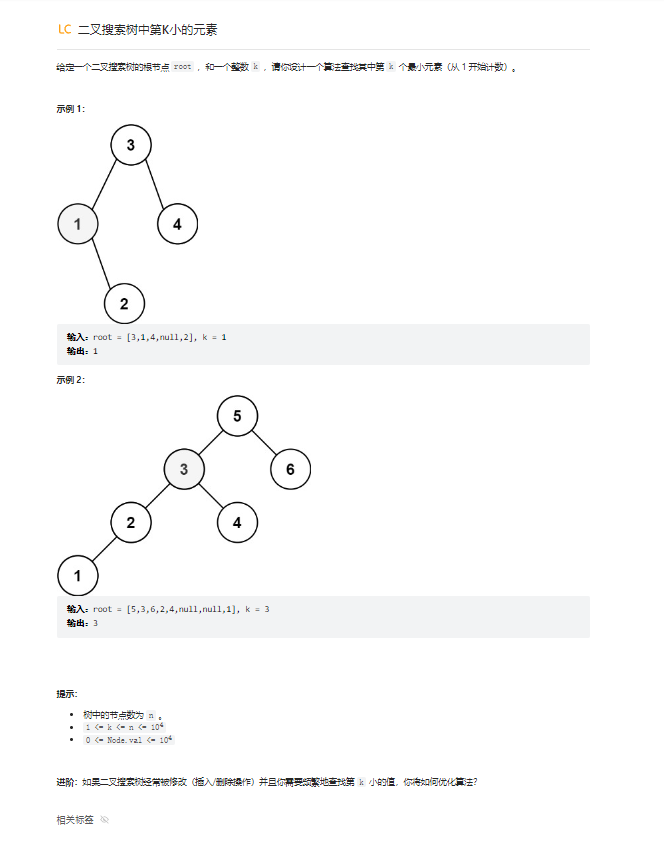
原题出处:https://leetcode.cn/leetbook/read/top-interview-questions-medium/xvuyv3/
解法一:
/**
* Definition for a binary tree node.
* public class TreeNode {
* int val;
* TreeNode left;
* TreeNode right;
* TreeNode() {}
* TreeNode(int val) { this.val = val; }
* TreeNode(int val, TreeNode left, TreeNode right) {
* this.val = val;
* this.left = left;
* this.right = right;
* }
* }
*/
class Solution {
int count = 1;
int target = -1;
public int kthSmallest(TreeNode root, int k) {
count = k;
mid(root);
return target;
}
public void mid(TreeNode node) {
if (node == null) {
return;
}
mid(node.left);
if (--count == 0) {
target = node.val;
}
mid(node.right);
}
}思路:
二叉查找树(英语:Binary Search Tree),也称为二叉查找树、有序二叉树(ordered binary tree)或排序二叉树(sorted binary tree),是指一棵空树或者具有下列性质的二叉树:
若任意节点的左子树不空,则左子树上所有节点的值均小于它的根节点的值;
若任意节点的右子树不空,则右子树上所有节点的值均大于它的根节点的值;
任意节点的左、右子树也分别为二叉查找树;
根据上面的性质,我们就能够知道,我们通过一个中序遍历,就能够得到一个有序的数组,然后我们根据k的值拿到对应数组值即可。
中序遍历:
public void mid(TreeNode root) {
if (root == null) {
return;
}
mid(root.left);
System.out.println(root.value);
mid(root.right);
}解法二:
/**
* Definition for a binary tree node.
* public class TreeNode {
* int val;
* TreeNode left;
* TreeNode right;
* TreeNode() {}
* TreeNode(int val) { this.val = val; }
* TreeNode(int val, TreeNode left, TreeNode right) {
* this.val = val;
* this.left = left;
* this.right = right;
* }
* }
*/
class Solution {
public int kthSmallest(TreeNode root, int k) {
int size = count(root.left);
if (size >= k) {
return kthSmallest(root.left,k);
} else if (size + 1 == k) {
return root.val;
} else {
return kthSmallest(root.right,k-1-size);
}
}
public int count(TreeNode node) {
if (node == null) {
return 0;
}
return 1 + count(node.left) + count(node.right);
}
}思路:我可以先统计出从根节点出发的左子树数量,如果数目大于或等于k的值,那么就继续递归左子树,数目+1等于k的值,那么就表示,当前的值就是我们要找的值,否则,我们就遍历右子树,注意在遍历右子树的时候k的值要减去1和左子树的数量。